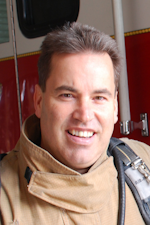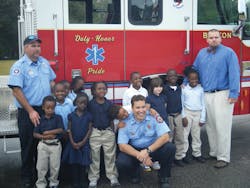Fire Prevention Week 2011 (Oct. 9 – 15) is closing in and too many fire departments will approach this important opportunity in a buckshot-reactive manner. Many fire department activities during this national public health observance, which is one of the longest health observances on record in the United States, will either be conducted without a consistent theme or message, or based upon a national theme that does not address your specific community issues; and countless firefighters, your number one advertisement and resource containing a wealth of knowledge and experience, are sitting in your fire stations behind bay doors unused and waiting to be requested.
Don’t let this be your fire department this year, and don’t waste this opportunity again.
As this week approaches, take the time to analyze your local statistics and find the top two or three reasons for fire calls in your community. Do not just look at flame to combustible cause, but look at the root cause that brings the flame to reaching the combustibles. For example, if your leading cause of fire is cooking, do not just address cooking fires, but why are they occurring? Are they occurring in the homes of elderly who are forgetful, in single-parent homes, in homes with children, etc.? What can you do to address and correct the root cause? Not only does understanding this help you design an effective approach to address the issue in its entirety, but allows you to understand the dynamics behind the problem, which will enable you to better shape your message and delivery – and just as important develop rapport with your target community.
Once you understand what your problem is in its entirety, and you know the communities most at risk, you can create a three-dimensional educational message to (1) prevent the fire (2) extinguish or contain the fire and (3) survive the fire; now plan your program.
Educate Your People First
If your people are not educated on the problem, how can they effectively educate your citizens? All of your firefighters should know the leading causes of fire and how to prevent them; thus, what to look for when going into homes and how to educate the residents in a manner that will change the behaviors and attitudes leading to the hazard. Your firefighters should all be carrying with them the same messages on topics such as; where to mount fire extinguishers, what size extinguisher a home should have, the best locations for smoke detectors, the dangers of “dead air spaces,” etc.
Your firefighters who are out in your community meeting with your citizens should also know what educational materials you have out there and what programs you have presented; not only is this a conversation piece to generate a fire prevention discussion, but it will allow them to gauge your program’s effectiveness and provide you with feedback on what the “buzz on the street” is. Proving your program’s worth is the new focus in fire prevention today, and this is probably the best method to not only finding out what your citizens have learned, but most importantly what had been retained.
One Community at a Time
Has a supervisor ever told you to “eat that elephant one bite at a time?” Well it applies to fire prevention as well. “One person, one life, at a time!” If your resources and time are limited, then focus all of what you have on your biggest risk neighborhoods.
Learn the Neighborhood
In addition to understanding the total dynamics to your fire problem, take the time to understand the community in its entirety. Who are the community leaders, both formal and informal, who can help with coordination issues and helping you get a program going. What school services that community? What other groups already conduct activities there?
Take informal surveys of the homes and families in these neighborhoods during EMS and service runs. How many have smoke detectors? How old are they and are they being maintained? What is the fire prevention knowledge of the residents? Are there any community events coming up and what types of events do the people in this community enjoy or want?
Build a Team
What other resources are available to you to help you during this week? Choosing your resources also depends on your knowledge of the community you want to get into and what their interests are and what would generate participation from this community. Is there a popular local church, restaurant or a fun park that could help by providing activities or even food when doing an event?
What is your fire problem and can you solicit local businesses to help out? For example, if cooking is your leading cause of fire would a local department store donate fire extinguishers or coupons for those citizens who do participate? Would they be willing to have sales during fire prevention week on items that are pertinent to your program and problem, or place those items in the front of the store for quick recall when customers come in and thus make them more likely to purchase them?
Your presentation may be the teachable moment when someone needs to decide if a fire extinguisher is needed in their home, and seeing one on sale as they first walk into the local store may be all it takes to prevent a fire.
Check with your local police department. It is not too much of a stretch to assume that the community you have determined is a target is the very same community your police officers are often in as well. Many police departments have already held a “National Night Out” in these communities and may have contacts and lessons learned.
Design a Message
While national themes may apply to your community, many times it is best to create your own and incorporate not only your leading fire problems, but also the culture of your community; a message that connects with the values and dynamics of the people who you are trying to reach.
Contact and Plan
Make contact with the community leaders (formal and/or informal) and schedule a meeting. Face to face is much better than phone or email. Be prepared to have to sell your program/presentation plan, and do not be surprised when you get a lukewarm reception to your idea. Remember, they are the customer and it is all about them.
If you have to scale back or adjust your program to what they want – do it! Keep your main messages in focus and get creative to incorporate them into whatever program they prefer! If this is your first program, the idea is to make a great first impression, display your daily value and establish a “beach head” for further activity. As you work more and more with this community, you will find your programs will expand and they will be more receptive to your approach.
Make sure you have a full understanding of what they want. For example, they do not understand the maneuverability of your fire apparatus and the difficulty in getting into/and out of certain spaces, or understand that your educational prop may require electricity that you do not provide. Your version of what they want and their version of what they want and the need for certain accommodations could be way off.
If you’re bringing the “bling” (fire hats, stickers, etc) then make sure you have enough for everyone. Use the bling to create some type of incentive to perform a skill that will develop the psychomotor skills they will need to prevent, extinguish/contain, or survive a fire. If they complete the skill, they get the bling.
Carry It Out
Make sure you touch base a week out, 48 hours out and 24 hours out. Not only does this demonstrate your professionalism and commitment, but verifies that there have been no changes to the plan and the principle players are still principle. Do not get your feelings hurt if there have been changes and you were left off the notification list; until you have an established relationship and have become a permanent fixture at community events this will happen.
Be prepared when you show up that you have a plan A, B and even a plan C. No matter how much you have covered all the details and verified them, come game day, things will change. Be flexible and positive! Remember, you are there for them and it is all about them! These are civilians and many of the people who plan and coordinate community events mean well and have big hearts, but often they are volunteers and have their hands in everything. So, be prepared to alter your plan in a positive manner!
Go in with a plan, and make sure all personnel have talking points or questions to stimulate pertinent questions and discussions. Do not allow your personnel to hang around the apparatus and talk amongst themselves and give the appearance of being uninterested and disconnected from the community and the citizens.
Follow Up
Gather names, mailing and email addresses, and as much information as you can gather. Send the community leaders a “thank you” for the invite and the help. If the community has a newsletter, publish a small story of your event and your appreciation.
Maintain contact through email. Email – if used reservedly – can be a very useful tool to: continue safety messages, learn about changes in community leadership, keep your fingers on the pulse of the community and find new ways to get in there. Your emails can be constant reminders of having community events, of your role in their community and your value in their lives.
A solid year-around effective fire prevention program doesn’t cost anything but time and effort. The payoff is not only a reduction in fire and a reduction in exposed risk to your firefighters, but a continued demonstration of the value your department provides to your community every day, not just once a year during a week in October.
Do not let this year’s Fire Prevention Week go by without making the most of it; both in the community through fire reduction and in your department’s ability to work with the community utilizing your firefighters’ knowledge and skills in fire prevention activities. Do not approach this Fire Prevention Week in the same “buck shot” approach as has been done in the year’s past. Commit yourself and your department to making a difference this year.
Focus on one community, one person and one life at a time. That life may be yours.
DANIEL BYRNE, a Firehouse.com Contributing Editor, is a firefighter/paramedic, with the Burton Fire District in Burton, SC. A 20-year veteran of the emergency services, he holds both an associate and bachelors degree in fire science, is a National Fire Academy Alumni, and a veteran of the Desert Shield/Storm war with the U.S. Marine Corps. Daniel is the recipient of local and state awards for public educations and relations. Daniel is moderator of the Fire Prevention and Life Safety forums on Firehouse and has been guest on two Firehouse.com podcasts: 2010 Fire and Life Safety Roundtable and Developing and Adapting Successful Fire Prevention Applications. View all of Daniel's magazine and online articles here. You can reach Daniel by e-mail at [email protected].

Daniel Byrne
DANIEL BYRNE is a community support officer for the Burton Fire District, Beaufort County, SC, and a retired assistant fire chief of training for the Georgia Air National Guard 165th Fire Department. A third-generation firefighter, he holds an associate degree and a bachelor’s degree in fire science as well as a master’s degree in public administration and disaster management. Byrne is an alumnus of the National Fire Academy. He received state and local awards for public relations and educational programs as well as community partnerships and served as a conference presenter and keynote speaker.






